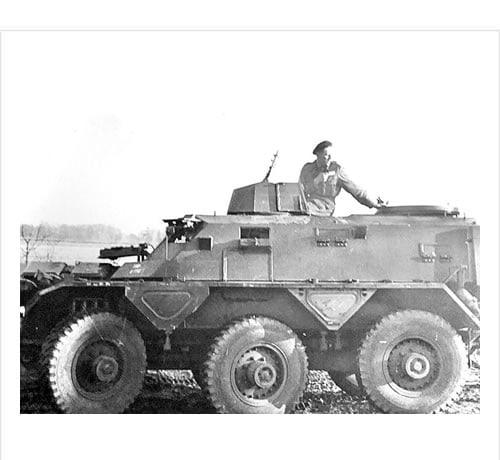The Saracen was an early Cold War-era armoured personnel carrier/command vehicle that entered service in the 1950s.
The QRIH would be issued a number of them in 1958/59 as part of the conversion from Tanks to the reconnaissance role.
The Saracen was developed in the same program as the Saladin armoured car and several other vehicles called the FV600 series and shares many automotive components with them. It was armed with a .30 Browning M1919 machine gun in a one-man turret. Additionally, there was a ring mount at the rear which may feature a Bren/LMG.
It was powered by the Rolls-Royce B80 engine, the Mark 6A which had a power output of 160hp. It was an eight-cylinder in-line petrol engine attached to a fluid flywheel driving through a five-speed each-way Daimler preselector gearbox with a single-speed transfer box attached. This contained the forward/ reverse selector and the primary differential with drive shafts running along the inside of the hull.
Each road wheel featured epicyclic hub reduction gears and steering (hydraulically assisted) worked on the front and centre axles. Thus, one had four-wheel steering on the vehicle, while the suspension was provided by longitudinal torsion bars. In theory, at least a Saracen could run with any two-wheel stations out of action.
However, when the vehicle was driven a long way on a hard surface, stresses would build up in the driveline, perhaps due to a tyre on one side being more worn than its opposite number and the only way to relieve this was to drive the vehicle in such a way that one side-mounted the kerb every so often so that the stress was relieved. At cross country, this did not matter so much because the problem was taken care of by a wheel slipping on soft ground.
Armour protection ranged from 12mm at the front of the hull (16mm on the front of the turret) down to 8mm on the roof. This was generally deemed to be effective against rifle fire and grenade blasts, but these were the days before full NBC protection was considered vital and was not available.
Speed was a maximum of 45mph on the road and an average of 20mph at cross country, while the weight of a fully stowed vehicle was reckoned to be 10.25 tons. One recurring problem was that exhaust fumes could be sucked in by the mushroom ventilators on the right side, the effect in a hot climate was rough on the passengers who were almost suffocated. This was ultimately cured by the adoption of reverse flow cooling.
What makes the Saracen so remarkable to modern eyes is that, in addition to a crew of two, driver and commander in the turret, it had seats for ten infantrymen. The section commander and wireless operator occupied forward-facing seats behind the driver while the other men sat, four on each side, facing one another across the vehicle.


